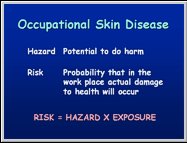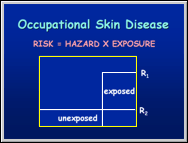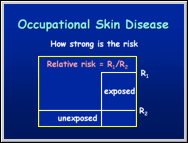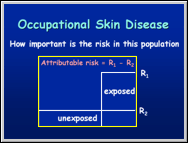 |
| Module 4: Occupational Skin Disease - Risk And Allergic Skin Disease |
 |
| Module 4: Occupational Skin Disease - Risk And Allergic Skin Disease |

Although the terminology of occupational health will have been discussed elsewhere, certain aspects need re-emphasis especially for allergic contact dermatitis understanding and management.
A hazard is something that has the potential to do harm.
A risk is the probability that in a particular setting actual damage to health will occur.
A risk can be expressed as the product of a hazard times an exposure.
 |
To evaluate the risk of a particular condition being due to an exposure one compares the risk of the exposed (R1) and unexposed (R2) populations. The significance of these risks is only appreciated relative to each other. |
| The strength of a risk is expressed at the relative risk, i.e. the ratio of risk in the exposed to the unexposed population, R1/R2. |  |
 |
The importance of the risk for a particular population is expressed as the attributable risk and it is the difference between the exposed population and the unexposed population, R1-R2. |
The data in the above diagram illustrates that a low relative risk common condition (sensitiser) can do more harm than a high relative risk condition (sensitiser), a concept core to understanding allergic contact dermatitis.
The population impact of 2 diseases such as lung cancer and heart diseases are compared. The relative risk for developing lung cancer is 14 compared to that for heart disease of 1.6. The risk for the exposed individual or population is high. However, because the prevalence of heart disease is much greater than lung cancer, the attributable risk for heart disease is much greater than lung cancer. The population impact is greater for heart disease than lung cancer.
In other words, low relative risk commonly occurring conditions (sensitisers) do more harm in the population than high relative risk uncommon conditions (sensitisers).
Expressed in occupational health terms, substances with high relative risk are easily identified and generally a great deal of effort is taken to prevent exposure to these products. They thus represent a high relative risk with low to rare exposure. To an individual who is exposed, the health consequences are large. However, to populations where exposure is rare, the health consequences are small.
Compare this to commonly encountered substances with low relative risk. For the individual the chance of developing disease when exposed is small. However when many people are exposed the chance of someone developing disease is higher.
When populations are compared to the individual, low relative risk common sensitisers do more harm than high relative risk sensitisers.
Allergic contact dermatitis develops when exposure to low relative risk sensitisers occurs in setting least expected. Usually the substances involved are not listed on material safety data sheets as, due to the recognised low relative risk; they are not considered hazards. Welcome to the world of Sherlock Holmes!

Postgraduate Diploma in Occupational Health (DOH) - Modules 3 – 5: Occupational Medicine & Toxicology by Prof Rodney Ehrlich & Prof Mohamed Jeebhay is licensed under a Creative Commons Attribution-NonCommercial-ShareAlike 3.0 Unported License.
Permissions beyond the scope of this license may be available at http://www.healthedu.uct.ac.za/